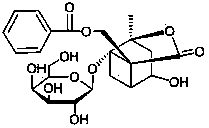Separation method of monoterpene and saponins components in traditional Chinese medicine composition vegetable drug midbody
A separation method and composition technology, applied in the direction of steroids, chemical instruments and methods, sugar derivatives, etc., can solve problems such as complex prescriptions and unclear basic mechanism of action of active substances
- Summary
- Abstract
- Description
- Claims
- Application Information
AI Technical Summary
Problems solved by technology
Method used
Image
Examples
Embodiment 1
[0091] The separation method of monoterpene and saponin components in the botanical medicine intermediate of the Chinese medicine composition, the weight of the botanical medicine in the Chinese medicine composition is as follows: ginseng 6kg, red peony root 5kg, jiangxiang 2kg, sandalwood 2kg, fried jujube seed 5kg, including The following steps:
[0092] Extraction: Weigh 4 kg of the above-mentioned botanical drug intermediate, dissolve it with 20 times the amount of water, then extract it with petroleum ether, ethyl acetate, and n-butanol successively for 3 times, and recover the solvent under reduced pressure;
[0093] Macroporous adsorption resin purification: Use D101 macroporous resin to roughly separate the n-butanol extract, elute with water, 30% ethanol, 70% ethanol, and 95% ethanol in sequence, and collect 30% and 70% of the eluent after concentration and drying. % ethanol elution site;
[0094] Take the fraction eluted with 30% ethanol, use a silica gel chromatogr...
Embodiment 2
[0106] The method for separating monoterpene and saponin components in the botanical intermediates of the Chinese medicine composition, the weight of the botanicals in the Chinese medicine composition is as follows: ginseng 6kg, red peony root 4kg, jiangxiang 3kg, sandalwood 2kg, fried jujube seed 4kg, including the following step:
[0107] Extraction: Weigh 4 kg of the above-mentioned botanical drug intermediate, dissolve it with 20 times the amount of water, then extract it with petroleum ether, ethyl acetate, and n-butanol successively for 3 times, and recover the solvent under reduced pressure;
[0108] Macroporous adsorption resin purification: Use D101 macroporous resin to roughly separate the n-butanol extract, elute with water, 30% ethanol, 70% ethanol, and 95% ethanol in sequence, and collect 30% and 70% of the eluent after concentration and drying. % ethanol elution site;
[0109] Take the fraction eluted with 30% ethanol, use a silica gel chromatography column, and...
Embodiment 3
[0121] The method for separating monoterpene and saponin components in the botanical intermediates of the Chinese medicine composition, the weight of the botanicals in the Chinese medicine composition is as follows: ginseng 3kg, red peony root 7kg, jiang xiang 4kg, sandalwood 3kg, fried jujube seed 3kg, including the following step:
[0122] Extraction: Weigh 4 kg of the above-mentioned botanical drug intermediate, dissolve it with 20 times the amount of water, then extract it with petroleum ether, ethyl acetate, and n-butanol successively for 3 times, and recover the solvent under reduced pressure;
[0123]Macroporous adsorption resin purification: Use D101 macroporous resin to roughly separate the n-butanol extract, elute with water, 30% ethanol, 70% ethanol, and 95% ethanol in sequence, and collect 30% and 70% of the eluent after concentration and drying. % ethanol elution site;
[0124] Take the fraction eluted with 30% ethanol, use a silica gel chromatography column, and...
PUM
| Property | Measurement | Unit |
|---|---|---|
| particle diameter | aaaaa | aaaaa |
Abstract
Description
Claims
Application Information
 Login to View More
Login to View More - R&D
- Intellectual Property
- Life Sciences
- Materials
- Tech Scout
- Unparalleled Data Quality
- Higher Quality Content
- 60% Fewer Hallucinations
Browse by: Latest US Patents, China's latest patents, Technical Efficacy Thesaurus, Application Domain, Technology Topic, Popular Technical Reports.
© 2025 PatSnap. All rights reserved.Legal|Privacy policy|Modern Slavery Act Transparency Statement|Sitemap|About US| Contact US: help@patsnap.com

